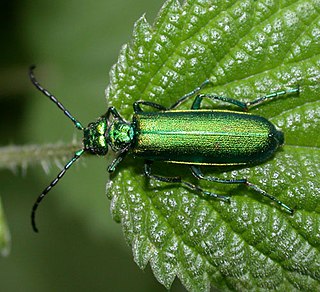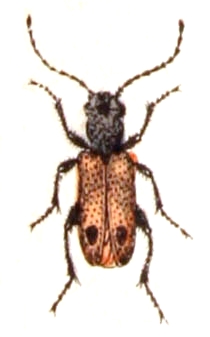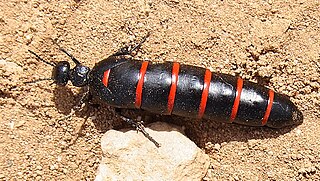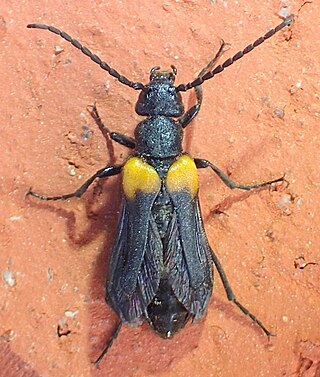
The Spanish fly is an aposematic emerald-green beetle in the blister beetle family (Meloidae). It is distributed across Eurasia.

Blister beetles are beetles of the family Meloidae, so called for their defensive secretion of a blistering agent, cantharidin. About 7,500 species are known worldwide. Many are conspicuous and some are aposematically colored, announcing their toxicity to would-be predators.

The Tenebrionoidea are a very large and diverse superfamily of beetles. It generally corresponds to the Heteromera of earlier authors.

The family Oedemeridae is a cosmopolitan group of beetles commonly known as false blister beetles, though some recent authors have coined the name pollen-feeding beetles. There are some 100 genera and 1,500 species in the family, mostly associated with rotting wood as larvae, though adults are quite common on flowers. The family was erected by Pierre André Latreille in 1810.

A planidium is a specialized form of insect larva seen in the first-instar of a few families of insects that have parasitoidal ways of life. They are usually flattened, highly sclerotized (hardened), and quite mobile. The function of the planidial stage is to find a host on which the later larval instars may feed, generally until the insect pupates.

Meloe is a genus of blister beetles commonly referred to as oil beetles. The name derives from their defensive strategy: when threatened by collectors or predators they release oily droplets of hemolymph from their joints. This fluid is bright orange and contains cantharidin, a poisonous chemical compound. Wiping the chemical on skin can cause blistering and painful swelling of the skin. This defensive strategy is not exclusive to this genus; all meloids possess and exude cantharidin upon threat.

Colletes hederae, the ivy bee, is a species of plasterer bee belonging to the family Colletidae subfamily Colletinae.

Lytta nuttalli, or Nuttall's blister beetle, is a species of North American beetle first described in 1824 by Thomas_Say. The genus Lytta is from a Latin word suggesting madness The specific nuttallii recognizes the contributions of Thomas Nuttall, a contemporary of Say.

Apalus is a genus of blister beetle from the family Meloidae. The species within the genus Apalus are parasitoids of solitary bees of the families Colletidae and Anthophoridae.

Berberomeloe majalis, the red-striped oil beetle, is an insect in the genus Berberomeloe, in the family of Blister Beetles. It is native to the western Mediterranean Basin.

Ceroctis capensis, or spotted blister beetle, is diurnal and endemic to Southern Africa occurring in diverse habitats, and belonging to the Meloidae or Blister beetle family. It secretes a toxic liquid from its leg joints when roughly handled, blistering human skin. This species somewhat resembles Mylabris oculata, a member of the same family.

Stenoria analis, the ivy bee blister beetle, is a species of blister beetle from the family Meloidae which is found in western Europe and North Africa and is a specialist cleptoparasite of the ivy bee larvae. Its occurrence in regions outside of the known range of the ivy bee, for example in North Africa, suggest that it has other hosts.
Lytta reticulata is a species of blister beetle in the family Meloidae. It is found in North America.
Meloe franciscanus is a species of blister beetle in the family Meloidae. It is found in the deserts of the southwestern United States. The larvae are parasites of bee larvae, eating them and consuming their provisions.
Tegrodera aloga, the iron cross blister beetle, is a species of blister beetle in the family Meloidae. It is found in Arizona, California, and Sonora.
Linsleya is a genus of blister beetles in the family Meloidae. There are about five described species in Linsleya.

Apalus bimaculatus, the early blister beetle, is a species of blister beetle from the family Meloidae. It is the type species of the genus Apalus.

Sitaris muralis is a species of blister beetle in the subfamily Nemognathinae in the family Meloidae. It is found in Western Europe. It is a black beetle with buff-orange patches on the front of the elytra. It is a kleptoparasite of digger bees.

Meloetyphlus fuscatus, the blind blister beetle, is a species of blister beetle in the family Meloidae found in Central and South America. They are kleptoparasites of orchid bees and are entirely blind as adults. Unique among meloids, females do not lay their eggs near flowers, but rather within their hosts' nests.

Physomeloe corallifer is a species of blister beetle native to the Iberian Peninsula, it is the only recognised species in the genus Physomeloe.















